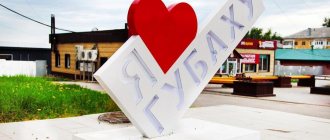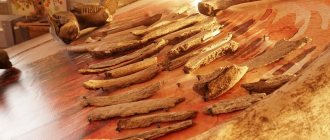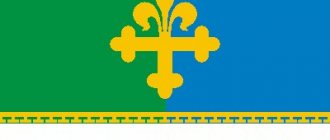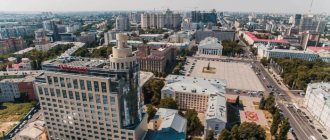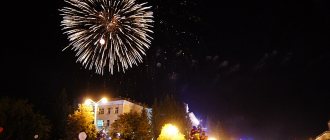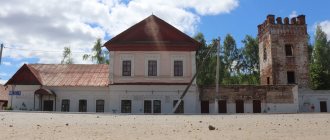Young people may not remember the birthplace of the leader of the Great October Socialist Revolution. But older people know that Vladimir Ilyich Lenin is from Simbirsk (now Ulyanovsk).
Then what does the small town of Lysva in the Perm Territory (formerly the region) have to do with this historical figure? Indirect, but quite significant. Thanks to his fellow countryman V.N. Nikandrov, who embodied the image of Ilyich on the screen in the first Soviet feature film “October” (1927).
The former cement factory worker, already retired by then, became a screen star thanks to his perfect resemblance to V.I. Lenin. He also starred in the films “Lenin in October” (1927) and “Behind White Lines” (1925).
Where is the city of Lysva, what is its history and today’s life, you will find out in this article.
Story
Initially, the land near Lysva belonged to the Stroganovs. In the second half of the 18th century, Princess Varvara Shakhovskaya became their owner, receiving an inheritance. In 1785, the princess began to build a cast-iron manufacturing plant on the banks of the Lysva River, which became operational a couple of years later.
Then this plant was inherited by Varvara Shuvalova. Together with their husband, they developed the enterprise. The famous Shuvalov brand in the form of a unicorn was well known in Europe.
Lysva iron covers the domes of churches and the roofs of many famous European buildings. In 1900, at an exhibition in Paris, it received a gold medal.
A village for factory workers was built around the plant. From here to Perm it is a little more than 80 km. From the mid-19th century, the settlement for factory workers became the center of the Lysvensky factory district.
Since 1926 the village became a city. Now there is not one plant, but several large enterprises: a metallurgical plant, oil engineering, reinforced concrete products. Today the population is about 61 thousand people.
You can call by city code 34249, index 618900. There is a train station and a bus station, from where you can easily go to Perm, Nizhny Tagil and many other cities. There is an official city website and Lysva television. The climate, as elsewhere in the Kama region, is moderate - continental. The average temperature is about 18 degrees.
Short history
In 1926 Lis'va became a city. However, the history started much earlier. The official year of Lis'va foundation is 1785. Exactly in this year princess Shakhovskaya, Stroganov's daughter, got a permission to establish today's Lis'va iron foundry factory and to start building it. The factory grew little by little, and the settlement around it was also increasing. In the nineteenth centery Lis'va has already been a center of the factory district. The production of the factory came out to country markets throug the built railway. The development of the industry and engineering started after the Great Patriotic War.
origin of name
Lysva is the name of not only the city, but also 3 rivers in the Perm region. On one of them there is a town of the same name. This word is made up of two words taken from the language of the ancient Komi people. Lyskoy means pine needles, wakoy means water. Figuratively speaking, this is a “river in a coniferous forest.”
In any self-respecting town, the guest will definitely be offered some kind of legend associated with the name. There is also a legend in Lysva.
Among the dense forest there was a monastery in which Old Believers lived who had fled Nikon's baptism. They were discovered by the Stroganov workers and forced to build a mill on a small stream. The clerk Sukhari did not listen to the talk that this was wasted work.
When the mill was erected, the manager arrived. He thanked the people for their work, and ordered Sukhari to be flogged. After all, the mill turned out to be a useless structure without sufficient water.
Sukhari screamed and cried. Everyone around them also cried out of pity, as did the nature around. A lot of water accumulated in the stream, the mill started working. The children ran and shouted: “Lys va” (in Komi-Permyak lys means forest, va means water, and all together means “forest water”).
Factory dam
The history of Lysva is closely connected with factory production, and any mining plant in the 18th century used the energy of falling water to operate its mechanisms. So he needed a dam. In 1787, such a structure blocked the bed of the Lysva River, and water began to accumulate in the pond. Four windows were left in the dam: two for discharging excess water, two for factory needs. Water was supplied to the blast furnaces through a wooden pipeline.
Today the pond and the dam are monuments of regional significance, located in the city center. There is a children's park on the shore of the pond, and its shores are favored by fishermen and vacationing townspeople.
Source
Attractions
Museums
MBUK Lysva Museum
This municipal institution is located in Lysva on Mira Street, 4. A wooden building, which was built in 1904 with the money of Count Shuvalov. Since 1957, a metallurgical plant museum was opened here, which in 2008 grew into a city museum.
This cultural institution, which today is a regional architectural monument, is called “The People's House, built at the expense of P.P. Shuvalov.” The exhibition includes exhibits dedicated to the history of mining in Russia. Here you can learn the story of the first diamond mined in our country.
MBUK "Lysvensky Museum" placed its exhibitions in another historical building at 2 Mira Street. This is the "House of the owner of the plant Shuvalov."
Here are exhibits of one of the most carefully preserved Ural brands - Lysva enamel. Visitors will discover the secrets of industrial espionage and how enamel could be one of the types of ideological weapons.
In the “Enamel Workshop”, tourists are given the opportunity to make a beautiful enamel plate with their own hands and take it as a souvenir.
The cultural institution is open 6 days a week, except Mondays, from 12 to 17-30. By calling +7(34249)3-00-65 you can order a bus tour to explore the city’s attractions.
Helmet Museum
Has the address: Perm region, Lysva, st. Mira, 4. Created in 2009. When the Great Patriotic War was going on, helmets for soldiers of the Soviet Army were produced in Lysva. In addition to them, the museum of the same name displays protective helmets from ancient times, not only made in Russia.
Here you can touch and even try on steel protection for soldiers’ heads, produced in almost all countries of Europe and the USSR.
Museum of Enamel Ware and Frits
Located in Lysva, on the street. Metallistov, 1. It has 2 halls, the exhibitions of which are dedicated to the development of the industry producing enamelware for Soviet and now Russian housewives.
Tourists visit the production itself, where they are even allowed to depict something on the masterpieces that serve as decoration for any kitchen.
Museum of Communications
Located at: Perm region, Lysva city, Pobedy Avenue, 40. It was organized back in 1980 on the initiative of the well-known local historian S.R. Golyshev. It contains rarities that are older than in a similar museum in Perm.
Among them are mail chests and suitcases, and bells for mail stagecoaches. The decoration of the exhibition is an icon and souvenir from the crowned Romanovs.
This is a gift from Tsarina Alexandra Feodorovna Romanova to Guryan Oborin, a wounded soldier in peacetime, a postal worker from the city of Lysva, when he was in the hospital after being wounded at the front during the First World War. In 2010, the museum moved from the Lysvensky post office to premises owned by Rostelecom.
Theater Museum
A recognized city of theatergoers, where the Festival of Theaters of Small Towns of Russia was held for several years, it has its own museum dedicated to the rich history of the local theater.
First opened in 1988. But in 1993 there was a severe fire in which the theater building was greatly damaged. From the rescued exhibits, the recreated museum found a second life. Located at: 618900, Perm region, Lysva, st. Mira, 31.
Temples
In the Lysvensky district, the most architecturally interesting building is the Holy Trinity Church in a historical place called Kyn-zavod. The brick church was built in 1864 with the money of the Stroganovs. The five-domed church was divided into two parts: cold and warm temples.
The Stroganovs ordered a project in the style of the 17th century, laconic and upward-looking. This architectural monument is known by another name: “ship temple”.
The village of Kyn-zavod has existed for more than 260 years. In the village of Kyn, Perm Territory, a metallurgical plant was built in 1759 by Nikolai Stroganov. The mountains on which the village was scattered were named after the temples located on them.
Orthodoxy penetrated and developed in a remote forest place where the Kyn River flows into the Chusovaya River. Under Soviet rule, many of the churches were closed and church property was looted. In particular, in 1937 the Holy Trinity Church in the village of Kyn was closed - the plant.
Church of St. John the Evangelist
Located at the address: Smyshlyaeva street, no. 94. In 1850, a chapel in the name of John the Evangelist was built near the village cemetery. It was used to see off dead townspeople on their last journey. Presumably, since 1953, this chapel became a temple, in which even during the Soviet era worship was held.
Church of the Great Martyrs Constantine and Arkady
Located in the city of Lysva on Zuevskaya Street, 15A. The wooden functioning church of the Great Martyrs Arkady and Konstantin Shamarsky.
Cathedral of the Life-Giving Trinity
Address: st. Revolutions, 2A, Lysva. It's near the fire station. The first Holy Trinity Church in the village at the Lysvensky plant was built in 1799 from wood, with the money of Princess Varvara Shakhovskaya. In 1989, a stone church with the same name was erected on the site of the burnt one.
It was closed in 1930. Since 2009, they began to build a new one, completely reproducing the historical building, using donations. Now it works.
Mosque
Located in Lysva on V. Mayakovsky Street, no. 129. Daily visits from 12 to 14 hours.
Architectural landmarks
House of the Shilov merchants with trading shops
In pre-revolutionary years, the place was called Torgovaya Street. Here stands the oldest city mansion, which belonged to the Shilov family.
At first it was 2 different buildings. They were separated by a gate. In one of them there were shops and a merchant’s office on two floors. The second was intended for family living. Address: st. Smyshlyaeva, 32.
House of Count Shuvalov
The mansion of Count Shuvalov was built as a guest house to accommodate the count's family in case it appeared in these parts. Now the Shuvalov House is an architectural monument and a cultural heritage site. Address: st. Mira, 2.
House of merchant Yaroslavtsev
Located in the city at the address: Kirova St., no. 4.
Kalancha
This is the highest place from where you can see the entire city. That's what the Lysven people call it.
Factory office (factory management)
Built in 1914. The pediment has beautiful carvings and is decorated with carved window frames. Located at: Metallistov Street, 1.
Church - parish school
Address: st. Mira, 6. The brick building of the parochial school in Lysva was built in 1908 for 120 children. People who glorified their hometown studied here.
Memorial plaques have been placed in their memory. This is Hero of the Soviet Union Yevgeny Nilovich Ivanov, as well as the poet, Tatar by nationality, Khasan Tufan, who taught here.
Monuments
Park of Soviet Sculpture "Shchusevsky Quarter"
Plaster sculptures found on the territory of the Zorka pioneer camp were displayed on the park alley. All of them are from the era of the monumentalist movement in the thirties of the last century. Address: st. Lenina, 26g.
Monument to the Heroes of the Civil War
The fraternal cemetery next to the so-called Popovsky Garden was intended for the graves of city residents who actively fought against the White Guards during the Civil War. You can see the monument on Kommunarov Street, in the park not far from house No. 98.
Monument to Count Shuvalov
Workers and employees collected money and erected a monument to the count in 1908. In 1918, the figure of the count was thrown into a pond by revolutionary citizens, where he safely drowned. Two decades later, V.I. was erected on an ownerless pedestal. Lenin.
And in 2009 they decided to return Count Shuvalov to his rightful place. This is an exact copy of the first monument, made of cast iron. It is located not far from the Shuvalov Palace.
Memorial of Military Glory
The memorial was opened on May 9, 1967 in memory of the townspeople who did not return from the war. About 5 thousand city residents gave their lives on the fronts of the Great Patriotic War. 10 people became Heroes of the Soviet Union.
Sculpture “Winged Swing” on the Square of Flowers
October 2014 was remembered by the townspeople for the grand opening of the “Winged Swing” monument on the city Square of Flowers.
A girl riding on a swing reminds everyone of the beautiful song of the same name by Lysva’s fellow countryman Evgeniy Krylatov, whose songwriting is dearly loved by many Russians.
Springboard
A ski complex was built near Lysva, in the area of the village of Ryumino. It included: a clearing, tracks, 3 jumps. Various skiing competitions are held here. The K-30 springboard has a summer surface.
Zaimkovsky waterfall
In the Lysvensky urban district, in the village of Zaimka, in the area of Yubileinaya Street, you can admire the waterfall. It looks especially beautiful in winter, with frozen streams.
Savin Drama Theater
The Lysvensky Theater appeared in 1944, when the USSR was waging a bloody war with Nazi Germany. It would seem that this is not the best time for culture and art. But not in our spiritually rich country.
The building in which the theater is located was built in 1906. Then it was intended for students of a vocational school to perpetuate the memory of the Shuvalov family. After all, the city of Lysva was the capital of a large district of these aristocrats - industrialists.
The factories had their own drama clubs and amateur performances. But only the newly rebuilt building had a stage and a large hall for spectators.
Acting troupes and a theater group that came to the town, led by the wife of a factory worker, Tatyana Shpinova, showed performances here.
By 1917, there were several dramatic associations in Lysva (“Enlightenment”, “Internationalists”). They had a rich and varied repertoire (A. Chekhov, L. Andreev, A. Lunacharsky).
After the Civil War, which significantly destroyed the economic life of the Ural town, the cultural center in the vocational school did not stop cultural and educational activities. On the contrary, a metal club began to operate here.
Ordinary residents of the city without acting education and amateur director V. Maltsev showed the plays “The Thunderstorm”, “The Gadfly”, “At the Depth”. Even city party and Komsomol leaders temporarily became artists.
As the metallurgical plant was restored and reconstructed, Lysva regained its briefly lost position as one of the largest centers of Ural industry.
In the thirties of the last century, all the most famous theaters of Leningrad and Moscow toured the city. At the same time, they continued to develop their own amateur performance groups. In 1929, the Theater of Working Youth (TRAM) was created.
And just before the war, in 1940, the final decision was made to open a drama theater. Already in the first season, the troupe staged a dozen and a half performances. But the terrible year 1941 came. The actors left to fight for their homeland. Those who remained worked in traveling operetta and comedy theaters.
The Lysvensky Metallurgical Plant supplied shells for the Katyusha and Andryush, cartridges and many other products to the front. But cultural life also did not subside. The poet’s words that times do not choose are always relevant.
No one was going to die; both the cinema and the Palace of Metallurgists were open. At the request of the townspeople, the Council of People's Commissars allowed the opening of a drama theater.
And already on October 7, 1944, the townspeople saw the premiere of F. Knorre’s play “Meeting in the Dark.” And in 1946, the play “At the Lower Depths” was awarded the first prize at the regional show.
The first cinematic leader of the Great October Socialist Revolution was from Lysva. Vasily Nikolaevich Nikandrov, who played the role of Lenin in the film “October” (1927, S. Eisenstein, G. Alexandrov), is a simple worker at the Lysva Mining and Metallurgical Plant. He turned out to be exactly like Vladimir Ilyich. Lenin's wife N.K. Krupskaya and sister M.I. Ulyanova were so amazed by the external resemblance that Nikandrov did not even need theatrical makeup.
2020 hit all sectors hard, including culture. All institutions were closed indefinitely. Lysvensky Drama Theater named after. A. Savina was no exception. Restrictions on visits are being lifted gradually, in accordance with the recommendations of Rospotrebnadzor.
And viewers who managed to purchase tickets before the introduction of the self-isolation regime, for the most part, did not return them to the box office. They waited patiently. Meeting with repertoire performances will undoubtedly please them.
The actors and theater managers decided to present Shakespeare's timeless plays in one evening. The premiere in the form of a two-hour skit in the comedy genre presents immortal creations, which the author himself observes, being present on stage.
You can get acquainted with the repertoire and buy tickets on the official website of the theater. By calling the box office (t.+7(34249)3-00-69), you can order a reservation. You can purchase tickets at the box office, open every day from 11 to 19 on weekdays, from 11 to 18 on Saturday - Sunday. Address: Mira street, 31, Lysva.
Palace of Culture of the Metallurgical Plant
The Metallurgists' Palace of Culture is located at: st. Lenina, 2. Today, this building of Stalinist architecture houses a cinema and shops.
Park of Culture and Leisure named after A.S. Pushkin
The park received the name of the great classic in 1937, when the poet’s centenary was celebrated. But the history of this attraction and favorite vacation spot for townspeople began in 1908. Then, in the vacant lot around the smoke-filled Lysva, through the efforts of the chief forester A.V. Zanuzzi laid out the park.
An original wooden gazebo in the style of Russian architecture was placed in the center. A brass band played in it.
Part of the territory, which was formalized under the leadership of A.V. Zanuzzi, preserved and is now a monument called "Regular City Park". Official address: Lysva, Perm Territory, st. Mira, 46.
Culture
Lysva can safely be called one of the cultural centers of the Perm region. Here is the general technical faculty of the Perm State Technical University, a medical school, a branch of a pedagogical school, and a polytechnic college. In addition to thirteen secondary schools, there is also a children's and youth sports school and a station for young naturalists.
Since 1944, a professional drama theater has been operating in Lysva. There are also libraries here, and the central library has one hundred and ninety thousand volumes of books, a children's art school, a Palace of Children and Youth Creativity, and Palaces of Culture for metallurgists and mechanical engineers.
Not far from Lysva there is a ski resort. The city is home to the Metallurgists' Stadium and the Park of Culture and Recreation, founded in 1908. Since 2009, the city has been operating the “Lysva – Deposit of Culture” program, within the framework of which the restoration of cultural monuments and landscaping work is carried out.
There are several museums in the city. The city museum houses eleven thousand exhibits telling the history of Lysva. There is also a communications museum, a museum of a Sberbank branch, a theater museum, a museum in a former factory hospital and some others.
How to get there
In the city of Lysva, on Smyshlyaeva Street, 51, there is a bus station, from which many vehicles depart to different settlements of the Perm Territory. There is also a train station.
The village of Kyn can be reached from Lysva in 3 hours. A daily bus leaves from the bus station at 16:00. There is also a shuttle bus “Kyn - Lysva” from the market square at 7-00.
Getting there by car is not very comfortable, as the road is not the best. There is also an electric train.
In the village of Kyn, tourists will find unique nature and architectural monuments. Here you can admire the unique rocks, which are called “fighters”. Each has its own interesting name, for example, “Sparrows”, “Money”.
Strike of 1914
At the beginning of the 20th century, a railway line was built to these parts, which made it possible to increase the supply of plant products both within the country and abroad. The number of workers in this region also grew. The events that rocked the country in 1905 did not spare the Perm region. In 1914, there was such an event in the history of the city of Lysva: the workers staged a mass uprising, putting forward certain demands.
Soviet historians qualified this event as a protest against mobilization into the army sent to the front of the First World War. Later studies clarified that the demands put forward were purely economic in nature. The list included increasing wages, reducing the working day to eight hours, eliminating fines, improving working conditions, and so on.
The mobilization announced at this time only added additional payments to the list for conscripted workers. After partial satisfaction of the requirements, people began to return to the workshops.
Interesting Facts
A very popular writer and screenwriter in the country, Alexey Ivanov created the work “The Unicorn Road”. The book tells about the history of the Lysvensky mountain district, the village of Kyn, which is now often mentioned in television programs of the “Culture” channel.
The famous ophthalmologist Svyatoslav Fedorov worked as a surgeon in the Lysvenskaya hospital in the fifties of the last century.
Not far from the city there is a border that divides Eurasia into 2 parts. True, there is no mark on the map about this.
